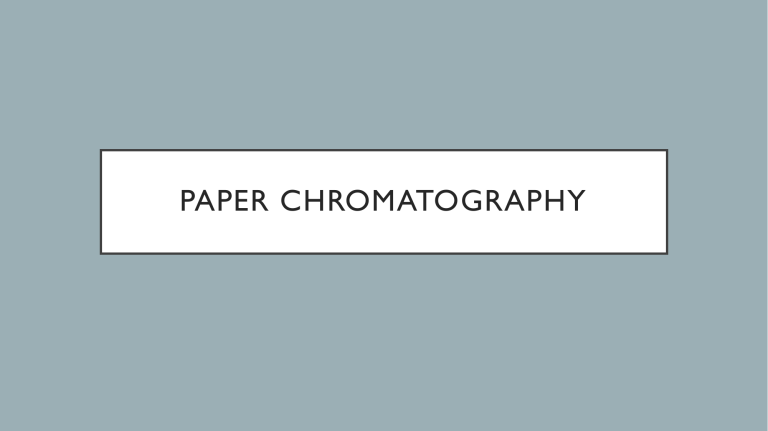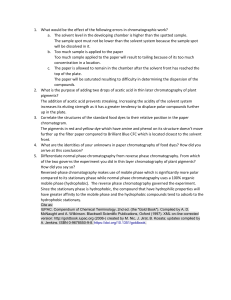
PAPER CHROMATOGRAPHY WHAT IS PAPER CHROMATOGRAPHY? • Paper chromatography (PC) is a type of a planar chromatography whereby chromatography procedures are run on a specialized paper. • PC is considered to be the simplest and most widely used of the chromatographic techniques because of its applicability to isolation, identification and quantitative determination of organic and inorganic compounds. • Russian Botanist Mikhail Tsvet was the first person to use chromatography in 1901 when separating an extract of green leaves through a glass tube filled with calcium carbonate DEFINITION AND KEY TERMS Detailed Definition: • Chromatography is a laboratory technique that separates components within a mixture by using the differential affinities of the components for a mobile medium and for a stationary adsorbing medium through which they pass. Terminology: • Differential – showing a difference, distinctive • Affinity – natural attraction or force between things • Mobile Medium – gas or liquid that carries the components (mobile phase) • Stationary Medium – the part of the apparatus that does not move with the sample (stationary phase) DEFINITION- SIMPLIFIED • Simplified Definition: • Chromatography separates the components of a mixture by their distinctive attraction to the mobile phase and the stationary phase. • • • • • Explanation: Compound is placed on stationary phase Mobile phase passes through the stationary phase Mobile phase solubilizes the components Mobile phase carries the individual components a certain distance through the stationary phase, depending on their attraction to both of the phases PRINCIPLE OF PC • The principle of separation is mainly partition rather than adsorption. • Substances are distributed between a stationary phase and mobile phase. • Cellulose layers in filter paper contain moisture which acts as stationary phase. • Organic solvents/buffers are used as mobile phase. • The developing solution travels up the stationary phase carrying the sample with it. • Components of the sample will separate readily according to how strongly they adsorb onto the stationary phase versus how readily they dissolve in the mobile phase. 1. STATIONARY PHASE AND PAPERS • Whatman filter papers of different grades like No.1, No.2, No.3, No.4, No.20, No.40, No.42 etc • In general the paper contains 98-99% of α-cellulose, 0.3 – 1% β -cellulose. • Other modified papers • Acid or base washed filter paper • Glass fiber type paper. • Hydrophilic Papers – Papers modified with methanol, formamide, glycol, glycerol etc. • Hydrophobic papers – acetylation of OH groups leads to hydrophobic nature, hence can be used for reverse phase chromatography. • Impregnation of silica, alumna, or ion exchange resins can also be made. 2. PAPER CHROMATOGRAPHY MOBILE PHASE • Pure solvents, buffer solutions or mixture of solvents can be used. • Examples• Hydrophilic mobile phase • Isopropanol: ammonia : water 9:1:2 • Methanol : water 4:1 • N-butanol : glacial acetic acid : water 4:1:5 • Hydrophobic mobile phases • dimethyl ether: cyclohexane kerosene : 70% isopropanol • The commonly employed solvents are the polar solvents, but the choice depends on the nature of the substance to be separated. • If pure solvents do not give satisfactory separation, a mixture of solvents of suitable polarity may be applied. 3. CHROMATOGRAPHIC CHAMBER • The chromatographic chambers are made up of many materials like glass, plastic or stainless steel. Glass tanks are preferred most. • They are available in various dimensional size depending upon paper length and development type. • The chamber atmosphere should be saturated with solvent vapor. RF VALUE- • Ratio of distance traveled by solvent spot to the distance traveled by the solvent front. • The distance travelled relative to the solvent is called the Rf value. Some compounds in a mixture travel almost as far as the solvent does; some stay much closer to the base line. The distance travelled relative to the solvent is a constant for a particular compound as long as other parameters such as the type of paper and the exact composition of the solvent are constant. TYPES OF CHROMATOGRAPHY • Liquid Chromatography – separates liquid samples with a liquid solvent (mobile phase) and a column composed of solid beads (stationary phase) • Gas Chromatography – separates vaporized samples with a carrier gas (mobile phase) and a column composed of a liquid or of solid beads (stationary phase) • Paper Chromatography – separates dried liquid samples with a liquid solvent (mobile phase) and a paper strip (stationary phase) • Thin-Layer Chromatography – separates dried liquid samples with a liquid solvent (mobile phase) and a glass plate covered with a thin layer of alumina or silica gel (stationary phase) ANALYSIS OF CHROMATOGRAMS AND RF VALUES • If the Rf value of one of the components of the mixture equals the Rf value of one of the standard reference materials then that component is know to be that reference material. • Note that because the solvent always travels at least as far as the highest dye, the Rf value is always between 0 and 1. • Dyes which are more soluble (less polar) will have higher Rf values than less soluble(more polar) dyes. • In other words, more soluble dyes move further up the paper. • The extreme case of this is for insoluble dyes which don’t move at all (Rf value = 0). • The other aspect affecting how far a dye travels is the affinity that dye has for the paper (how well it ‘sticks’ to the paper). APPLICATIONS OF PAPER CHROMATOGRAPHY • In the analysis of different classes of compounds namely: • Amino acids and organic acids • Alkaloids • Polysaccharides • Proteins and peptides • Natural and artificial pigments • Inorganic cations • Plant extracts APPLICATIONS OF CHROMATOGRAPHY • Reaction monitoring – The progress of the reaction can be estimated by developing the chromatogram over different time intervals by spotting the reactants. • Isolation & Purification – This technique is useful in the purification and isolation of components of mixtures. Here, the separated components on the paper are cut, dissolved in suitable solvents and using spectroscopic methods, their absorption is characterized at specific wavelengths. • Foods – Analysis of food colors in synthetic drinks and beverages, ice creams, sweets, etc. Only edible colours are permitted for use, this is why identification and quantification are of utmost importance. • Forensics – Provides a basis for identification and comparison against reference standards for drugs and their metabolites. Paper chromatography offers a vital role in the viable analysis of samples that are available in milligrams or microlitre quantities. • Pharmaceuticals – Provides information related to the development of new drugs molecules, reaction completion and progress of manufacturing processes. This process is cost-effective and hence used as an alternative method in monitoring the active ingredients present in the drug forms. Paper chromatography is also applicable in color identifications of pharmaceutical formulations.



